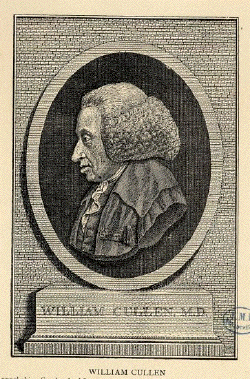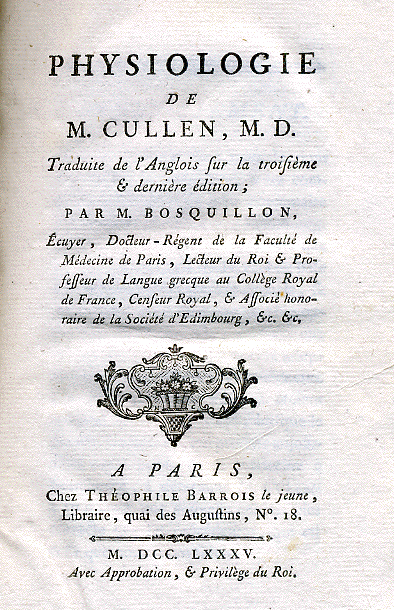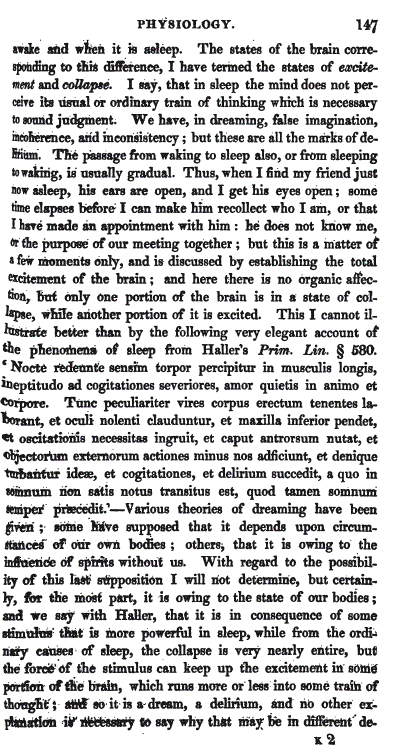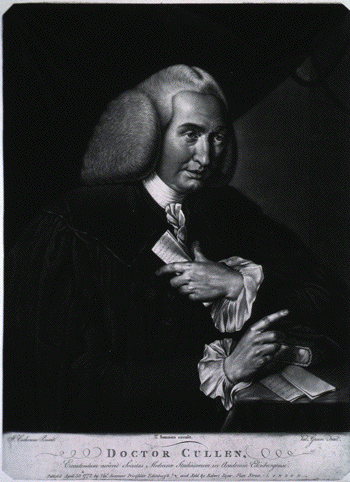  -
- chapitre
premier
- p6-7
-
- On désigne particulièrement
sous le nom de fièvres, les maladies
accompagnées des symptômes
généraux de pyrexie, sans
affection locale essentielle & primitive,
telle qu'on l'observe dans les autres ordres de
pyrexie.
-
- Comme les fièvres diffèrent
par le nombre & par la variété
de leurs symptômes, c'est avec beaucoup de
raison qu'on les a divisées en
différents genres & en
différentes espèces. Mais je pense
qu'il y a des symptômes communs à
toutes les maladies comprises dans cet ordre,
qui, par conséquent, sont essentiels
à la fièvre & en constituent
proprement la nature. Nous devons
spécialement, & avant tout, nous
occuper de la recherche de ces symptômes
que je crois trouver dans la manière dont
la forme, le plus communément, le
paroxysme, ou l'accès de la fièvre
intermittente.
-
- Les phénomènes que l'on
observe dans ce paroxysme, sont les suivans:
d'abord le malade est affecté de langueur
ou d'un sentiment de faiblesse; il
éprouve une paresse, ou un certain
malaise à exécuter les
différens
mouvemens; il y a des
bâillemens fréquens & des
pandiculations; la face et les
extrêmités deviennent pâles,
les traits du visage se retirent, les parties
externes diminuent de volume, la peau de toute
la surface du corps paroît
ressérée comme si elle avait
été saisie par le froid.
Dès que ces symptômes commencent,
l'on peut s'apercevoir, par le toucher, d'un
froid des extrêmités, auquel le
malade ne fait que peu attention.
-
- Ce n'est qu'au bout d'un certain tems qu'il
éprouve lui-même une sensation de
froid, qui commence communément dans le
dos, & bientôt se communique à
tout le corps; alors la peau paroît chaude
au toucher. Lorsque le sentiment de froid
s'accroit, il produit un tremblement dans tous
les membres, avec des secousses et des frissons
de tout le corps. Lorsque ce sentiment de froid
& ses effets ont continué
quelque-tems, ils deviennent moins violens,
& sont alternativement remplacés par
des bouffées de chaleur, qui produisent
des rougeurs du visage.
-
- Insensiblement le froid se dissipe
entièrement; une chaleur, plus
considérable que l'état naturel,
domine et se répand sur tout le corps.
Alors la peau reprend sa couleur, plus il
paroît, particulièrement sur le
visage, une rougeur extraordinaire. Pendant que
la chaleur & la rougeur surviennent, la peau
se relâche & est plus douce au
toucher, mais elle conserve sa sécheresse
quelque-tems. Les traits du visage & les
autre parties du corps reprennent leur volume
ordinaire, & même gonflent
davantage.
-
- Quand la chaleur, la rougeur & la
turgescence ont augmenté &
continué quelque-tems, il parôit
une légère humidité sur le
front; cette humidité se change, par
degrés en une sueur qui gagne
insensiblement les parties inférieures,
& se répand sur toute la surface du
corps. A mesure que cette sueur coule, la
chaleur tombe; la sueur elle-même,
après avoir duré quelque temps,
diminue par degrés; le corps reprend sa
température habituelle, & la plupart
des fonctions se rétablissent dans leur
état ordinaire.
-
-
  -
-
-
    
- 'Old Spasm': William Cullen (1710-90)
-
- Penelope Hunting
-
- Journal of Medical Biography 2010;18:
216&endash;217.
-
- No discovery, procedure or instrument bears
his name but one word is associated with Cullen:
neurosis, by which he meant a functional
derangement arising from disorders of the
nervous system. Cullen was convinced that a
disordered action or spasm of the nerves
provoked disease - hence his nickname, 'Old
Spasm'. He introduced the term neuroses in his
textbook First Lines of the Practice of Physic
(four volumes 1776-84), which went into many
editions and translations. The book was written
for medical students at the University of
Edinburgh where Cullen was renowned as an
innovative teacher. He chose to lecture in
English rather than Latin, using diagrams and
demonstrations; he gave clinical instruction at
the Edinburgh Royal Infirmary and his chemistry
courses attracted an increasing number of
students (rising from 17 in 1755 to 145 in
1766). During his 34-year career at Edinburgh,
Cullen was a leading figure of the Scottish
Enlightenment a founder of Edinburgh's Royal
Society of Medicine (1737) and of the Royal
Society of Edinburgh (1783); he was President of
the Royal College of Physicians of Edinburgh
(1773-5) and he was elected a Fellow of the
Royal Society in 1777. With his friend,
political economist Adam Smith (1723-90), Cullen
promoted the reform of medical education at the
Scottish universities and he was likewise the
lifelong friend of the philosopher David Hume
(1711-76). With his colleagues Professors Munro
primus (1697-1767), Munro secundus (1733-1817),
Robert Whytt (1714-66), John Hope (1725-86),
John Gregory (1729-73) and former pupil Joseph
Black (1728-99), Cullen established the
supremacy of Edinburgh's medical school in the
second half of the 18th century. Benjamin Rush
of Pennsylvania (1745-1813), who studied under
Cullen, testified that Edinburgh was then 'in
the zenith of its glory. The whole world I
believe does not afford a set of greater men
than are at present united in the college at
Edinburgh'.
-
- Born 300 years ago in Hamilton, Lanarkshire,
Cullen commenced practice in his hometown in
1736. After the death of his patron, the Duke of
Hamilton, Cullen moved to Glasgow to lecture on
chemistry, botany, physic and materia medica at
the University. In 1755 he transferred to the
University of Edinburgh, initially as joint
Professor of Chemistry; later he was appointed
Professor of the Institutes of Medicine and at
the time of his retirement in 1789 he occupied
the Chair of the Practice of Physic (Figure
1).
-
- Cullen's Synopsis Nosologiae Methodicae
(1769) presented a classification of diseases by
their symptoms and his First Lines of the
Practice of Physic (1776-84) expanded the
system. In addition to this magnum opus Cullen
wrote papers on artificial refrigeration,
linen-bleaching, salt-refining and
soil-fertility - these 'husbandry experiments'
attracted the interest of Scottish landowners
including the Duke of Argyll (1682-1761) and
Lord Kames (1696-1782). As a medical
practitioner Cullen's courteous manner and wide
experience (he had trained with an apothecary
and travelled to the West Indies as a ship's
surgeon in his youth) were particularly valued
by private patients who wrote to him describing
their complaints. For a fee of one guinea Cullen
provided a diagnosis, advice on diet and
lifestyle, and a prescription - to facilitate
this voluminous correspondence he acquired one
of the first mechanical copying devices,
invented by his friend James Watt in 1780. An
Italian prince, aristocrats, clergymen, army
officers and frail women consulted Cullen by
post, as did the diarist James Boswell who wrote
anxiously to Cullen in 1784 describing Dr Samuel
Johnson's asthma and dropsy for which Cullen
recommended laudanum, vinegar of squills
(sea-onion), blistering, issues, gentle vomits
and a mild climate. Cullen had dined with
Johnson some years previously when the
conversation had touched upon witchcraft and
whether orang-utans could speak, and Cullen
amused his host with tales of people who walked
and talked in their sleep.
-
- When Cullen died in 1790 signs bearing his
portrait hung outside apothecaries' shops
throughout Great Britain as a mark of respect,
while in North America Professor Rush paid
tribute to his mentor: 'It is scarcely possible
to do justice to this great man's character
either as a scholar, a physician or a man'.
-
-
- Reference and note
-
- 1 Cullen's only biography was written in the
19th century:
-
- Thomson, John. An Account of the Life,
Lectures and Writings of William Cullen (1832,
1859). The same author edited The Works of
William Cullen (1827)
|










